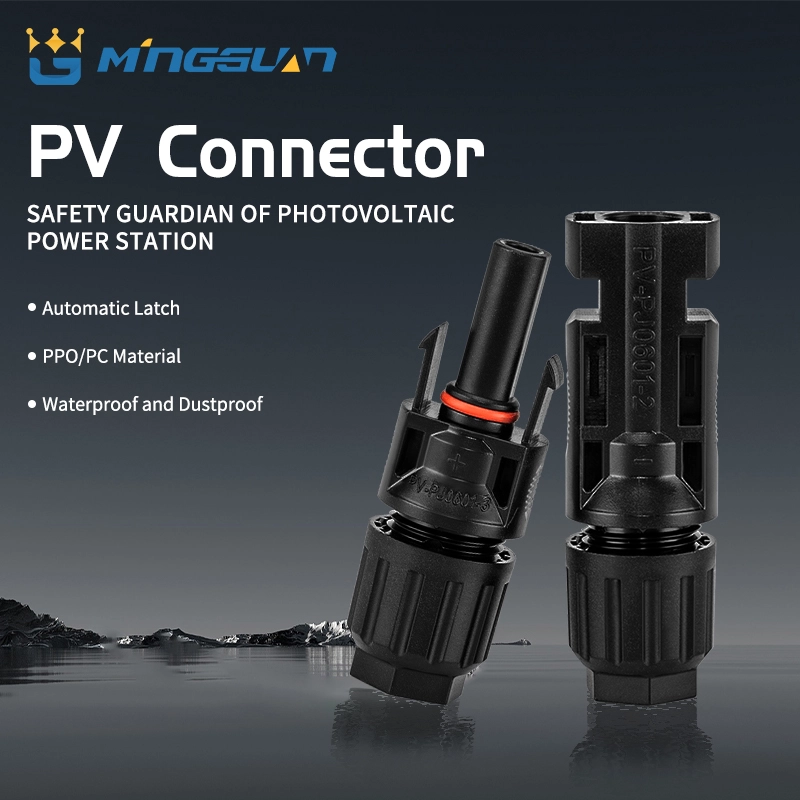As a key component of the solar power generation system, pv connectors play the role of connecting solar panels and other devices to ensure efficient, safe and continuous power transmission of the entire system. With the rapid development of the photovoltaic industry, the connector market has also shown significant dynamic changes and technological innovations. This article will provide an in-depth analysis of new products and innovative technologies in the current market, as well as future development trends.

Current market trends
1. Continued growth of market demand
The global demand for renewable energy has driven the expansion of the photovoltaic market, especially with the policy support of various governments, the number of installed photovoltaic installations continues to increase, and the demand for high-performance pv connectors is increasing day by day. An increasing number of large-scale photovoltaic projects have put forward higher standards for connectors, including higher current handling capabilities, longer service life and stronger environmental adaptability.
2. Wide application of modular design
The trend of modular design is widely used in photovoltaic systems. This design makes the installation and maintenance of photovoltaic modules faster and more efficient. Modular connectors can connect different photovoltaic components to the system in a more efficient manner, and require less installation skills from technicians, effectively reducing the overall construction cost of the photovoltaic system.
3. Promotion of compatibility and standardization
The standardization policy of the photovoltaic industry is being strengthened, and photovoltaic product standards in various countries and regions are gradually converging, which facilitates the interchange and compatibility of products between different manufacturers and brands. For example, with the introduction of specifications by organizations such as the International Electrotechnical Commission (IEC) and the National Electrical Manufacturers Association (NEMA), the compatibility of various types of pv connectors has been effectively enhanced. This trend has greatly promoted the interoperability between market products and promoted the integration of the global market.
Technology Innovation Overview
1. Self-locking design
The latest generation of pv connectors generally adopt a self-locking design, which is optimized for installation safety and convenience. The tool-less locking mechanism facilitates quick assembly, reducing safety hazards and misoperation during installation. For outdoor high-altitude operations or installation scenarios with harsh environments, the self-locking design is particularly important.
2. Improvement of waterproof performance
Photovoltaic systems are usually exposed to complex outdoor environments, and waterproof performance is crucial for the long-term use of connectors. Current innovative technologies such as high-performance polymers and precision sealing designs can provide better waterproof ratings (such as IP67, IP68), ensuring that connectors maintain their electrical performance even in heavy rain and high humidity conditions, and effectively prevent internal corrosion. .
3. Use of highly durable materials
In order to extend the service life of pv connectors, the application of new materials is continuously broadening their durability limits. The application of reinforced polymer plastics and special metal alloys makes connectors better resistant to aging, high temperature and chemical corrosion. These technological advancements not only improve product reliability, but also reduce later maintenance and replacement costs.
4. Integration of intelligent technology
Smart connectors are a new trend in the current market. These products are embedded with sensors and microprocessors, which can perform real-time electrical parameter monitoring and data transmission, providing key data support for system operation and maintenance. This technological innovation provides a new method for operation monitoring and fault detection of photovoltaic systems, which helps to provide early warning of potential system faults, reduce maintenance costs and improve the overall operating efficiency of the system.
future development direction
1. Improve the electrical performance of the connector
In the future, the market demand for high-voltage and high-current connectors will continue to grow. Driven by the goal of high efficiency and energy saving, the next generation of connectors will further optimize their electrical performance, improve transmission efficiency and reduce energy loss. The combination of unique conductor materials and high-precision manufacturing processes will make it possible to achieve smaller size and higher performance.
2. Environmental protection and sustainable design
The concept of sustainable development will promote the improvement of pv connectors in terms of environmentally friendly materials, energy efficiency, and product recycling. By using recycled materials and environmentally friendly manufacturing processes, the production of pv connectors will reduce environmental impact. At the same time, some companies have begun to explore product life cycle management to achieve recyclability and higher resource utilization.
3. Innovative packaging and design
To adapt to changing environmental conditions and the diversity of photovoltaic systems, future connector designs will focus more on the use of innovative packaging, such as UV-resistant materials and advanced shielding technologies. These designs significantly improve the connector’s adaptability in harsh environments such as extreme temperatures, salt spray, and sandstorms.
4. Integrate IoT and big data analysis
Technological development will promote the continuous deepening of connector intelligence. Future connectors are expected to be closely integrated with IoT systems to provide end-to-end data stream processing and big data analysis services. The integrated connector can be used for remote monitoring, remote fault diagnosis, and even automatic optimization and adjustment through the cloud platform to improve the operating efficiency of the entire photovoltaic system.
5. Cross-industry cooperation and development
With the advancement of photovoltaic technology, the connector industry will also engage in deeper cooperation and joint development with other industries. Cross-border applications in the automotive, construction, high-tech and other industries will drive new connector design concepts and develop more comprehensive, cost-effective products.
To sum up, the photovoltaic connector market is in a period of change driven by technological innovation and market demand. Connectors play a basic but vital role in solar systems, and with the introduction of new technologies, their performance and application range continue to expand. In the future, pv connectors will continue to play a central role in improving system efficiency, reducing operating costs, enhancing reliability and promoting sustainable energy development, helping the world achieve a cleaner and more reliable energy future.